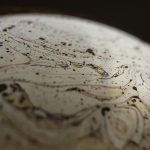To get stains out of acetate fabric, first identify the stain type and check the care label. Remove loose dirt gently, then try mild dish soap with cold water for food stains or baking soda for oil spots. For stubborn stains, test a commercial remover on a hidden area before applying it carefully. Avoid hot water and harsh scrubbing to protect the fabric. Keep handling tips in mind to maintain your acetate’s look, and you’ll find even more useful cleaning strategies ahead.
Table of Contents
Key Takeaways
- Identify the stain type on acetate fabric to choose the appropriate cleaning method.
- Test any cleaning solution on a hidden area before full application to prevent damage.
- Use mild dish soap and cold water for food stains, and baking soda for oil stains.
- Apply white vinegar for ink or red wine stains, then rinse thoroughly with cold water.
- For stubborn stains, use commercial stain removers safe for acetate, testing first on a concealed spot.
Identifying Different Types of Stains on Acetate Fabric
How can you tell what kind of stain you’re dealing with on acetate fabric? First, check the stain’s color and texture.
Grease or oil stains usually appear dark and feel slick or sticky. Protein-based stains like sweat or blood tend to be reddish or yellowish and may crust when dry. Ink stains are often sharply defined with bright or dark colors, while dye transfer stains look like blotchy patches.
Food and drink stains vary widely but often have a visible residue or discoloration. Knowing the stain type helps you choose the right cleaning method.
Preparing Acetate Fabric for Cleaning
Before you start cleaning acetate fabric, you need to prepare it properly to prevent damage. First, check the care label for specific instructions; acetate is delicate and often requires gentle handling.
Next, test any cleaning solution on a small, hidden area to verify it won’t cause discoloration or weaken the fibers. Remove any loose dirt or debris by gently shaking or brushing the fabric.
Avoid using hot water, as acetate can shrink or distort. Lay the fabric flat or hang it to maintain its shape during preparation.
Finally, gather all your cleaning supplies before you begin, so you can work quickly and effectively without interrupting the process. Proper preparation sets the stage for safe, successful stain removal.
Effective Home Remedies for Common Stains
You can tackle many common stains on acetate fabric using simple home remedies that are both gentle and effective. For example, a mixture of mild dish soap and cold water works wonders on food stains. For oily spots, sprinkle baking soda to absorb the grease before gently brushing it off. Red wine or ink stains respond well to white vinegar applied with a cotton ball. Always test any remedy on a hidden area first.
| Stain Type | Home Remedy | Result You’ll Love |
|---|---|---|
| Food Stains | Dish soap + water | Fresh, clean fabric |
| Oil Stains | Baking soda | Grease-free, soft texture |
| Ink/Red Wine | White vinegar | Bright, stain-free look |
These remedies keep your acetate fabric looking its best without harsh chemicals.
When and How to Use Commercial Stain Removers
Although home remedies work well for many stains, some stubborn marks on acetate fabric call for commercial stain removers. You should reach for these products when DIY methods fail or the stain is particularly tough, like ink or oil.
First, check the remover’s label to verify it’s safe for acetate. Test it on a hidden area to avoid damage or discoloration.
Apply the remover gently with a clean cloth or sponge, following the instructions carefully. Avoid soaking the fabric, as acetate can be sensitive to harsh chemicals.
After treating the stain, rinse thoroughly with cold water and let the fabric air dry. Using commercial stain removers correctly helps preserve your acetate’s look without causing harm.
Preventative Care Tips to Protect Acetate Fabric
Since acetate fabric is delicate and prone to staining, taking preventative measures can save you time and effort later.
Always handle acetate with clean hands to avoid transferring oils or dirt. When wearing acetate clothing, be cautious around food, drinks, and makeup to minimize exposure to potential stains.
Store acetate items in a cool, dry place away from direct sunlight to prevent discoloration and fabric weakening. Use padded hangers or fold garments carefully to avoid creases and fabric damage.
When laundering, follow care labels strictly and opt for gentle cycles or hand washing. Avoid harsh chemicals and bleach, as these can weaken fibers.
Frequently Asked Questions
Can Acetate Fabric Be Safely Machine Washed?
Since acetate is sensitive, you shouldn’t simply shove it into the machine. You can carefully choose a cold, gentle cycle and mild detergent, but always check the label first to avoid shrinking or damaging your delicate fabric.
How to Restore Shine to Dull Acetate Fabric?
You can restore shine to dull acetate fabric by gently steaming it and using a cool iron with a pressing cloth. Avoid harsh detergents, and try a fabric softener to bring back its smooth, glossy finish.
What Is the Best Way to Dry Acetate Fabric?
You should air dry acetate fabric by laying it flat on a clean towel or hanging it up. Avoid direct sunlight and heat sources, as they can damage the fibers. Don’t use a dryer to keep it safe.
Are There Professional Cleaning Services for Acetate Fabric Stains?
You’d think finding professional acetate stain cleaners is like hunting for a needle in a haystack, but you’re in luck! Many dry cleaners specialize in delicate fabrics, so trust them to restore your acetate’s pristine look.
Can Acetate Fabric Be Ironed Without Damage?
You can iron acetate fabric, but you need to be careful. Use a low heat setting and place a pressing cloth between the iron and fabric to avoid melting or shiny marks. Always test on a small area first.
- Does Chiffon Fabric Stink - July 15, 2025
- Does Chiffon Fabric Affect the Economy - July 15, 2025
- Does Cotton Fabric Have a Nap - July 15, 2025







